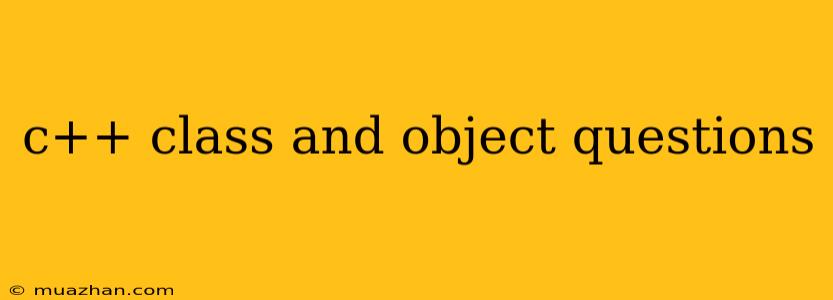C++ Class and Object Questions
This article will explore some common questions about classes and objects in C++. Understanding these concepts is crucial for object-oriented programming in C++.
What is a class?
A class is a blueprint or template for creating objects. It defines the attributes (data members) and methods (member functions) that an object of that class will have. Think of it like a cookie cutter – the class defines the shape, while the objects are the actual cookies.
Here's a simple example of a class in C++:
class Dog {
public:
string name;
int age;
void bark() {
cout << "Woof!" << endl;
}
};
This Dog class defines the attributes name (a string) and age (an integer), and the method bark(), which prints "Woof!" to the console.
What is an object?
An object is an instance of a class. It is a real-world entity that has the characteristics defined by the class. Think of it as an actual cookie made using the cookie cutter.
To create an object in C++, you use the following syntax:
Dog myDog; // creates an object named "myDog" of the "Dog" class
Now you have an object myDog with the attributes name, age, and the ability to bark().
Why use classes and objects?
There are several advantages to using classes and objects in programming:
- Code Reusability: You can create multiple objects of the same class, reusing the code defined in the class.
- Data Abstraction: Classes hide the implementation details from the user, presenting only the necessary information. This makes your code easier to understand and maintain.
- Data Encapsulation: Classes group data (attributes) and functions (methods) related to the object together, preventing accidental modification of data.
- Modularity: Classes can be used as building blocks for larger, complex programs.
What are constructors?
A constructor is a special member function that is automatically called when an object of the class is created. Its purpose is to initialize the object's attributes.
Here's an example of a constructor for the Dog class:
class Dog {
public:
string name;
int age;
Dog(string n, int a) { // constructor with parameters
name = n;
age = a;
}
void bark() {
cout << "Woof!" << endl;
}
};
Now, when creating a Dog object, you can pass the name and age:
Dog myDog("Buddy", 3); // initializes the object with the given name and age
What are access specifiers?
Access specifiers determine how members of a class can be accessed from outside the class. In C++, there are three access specifiers:
- Public: Members declared as public can be accessed from anywhere.
- Private: Members declared as private can only be accessed from within the class itself.
- Protected: Members declared as protected can be accessed from within the class and its derived classes.
It's important to choose appropriate access specifiers for your class members to maintain data encapsulation and control access.
What are inheritance and polymorphism?
Inheritance is a mechanism that allows a new class (derived class) to inherit properties and methods from an existing class (base class). This promotes code reusability and allows you to create more specialized classes based on existing ones.
Polymorphism is the ability of an object to take on multiple forms. This means that an object can respond differently to the same method call depending on its actual type. Polymorphism is often achieved through virtual functions in C++.
Conclusion
Understanding classes and objects in C++ is fundamental to object-oriented programming. This article has discussed key concepts such as class definition, object creation, constructors, access specifiers, and inheritance. Continue exploring these topics, as they are crucial for building well-structured and efficient C++ programs.
